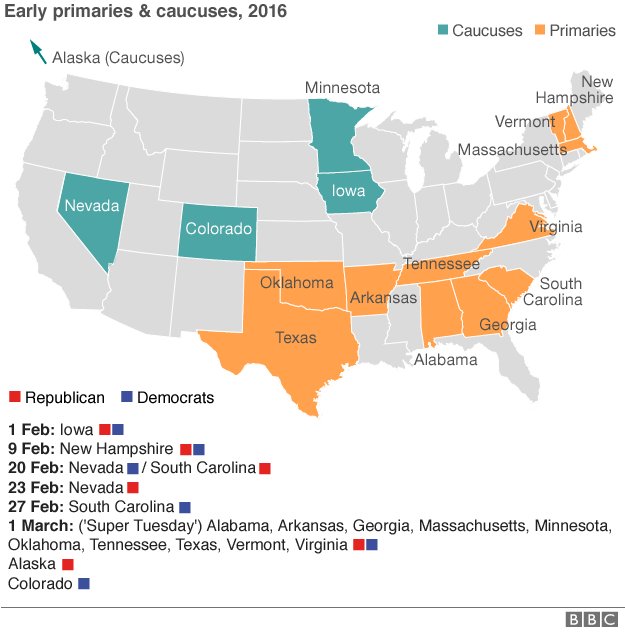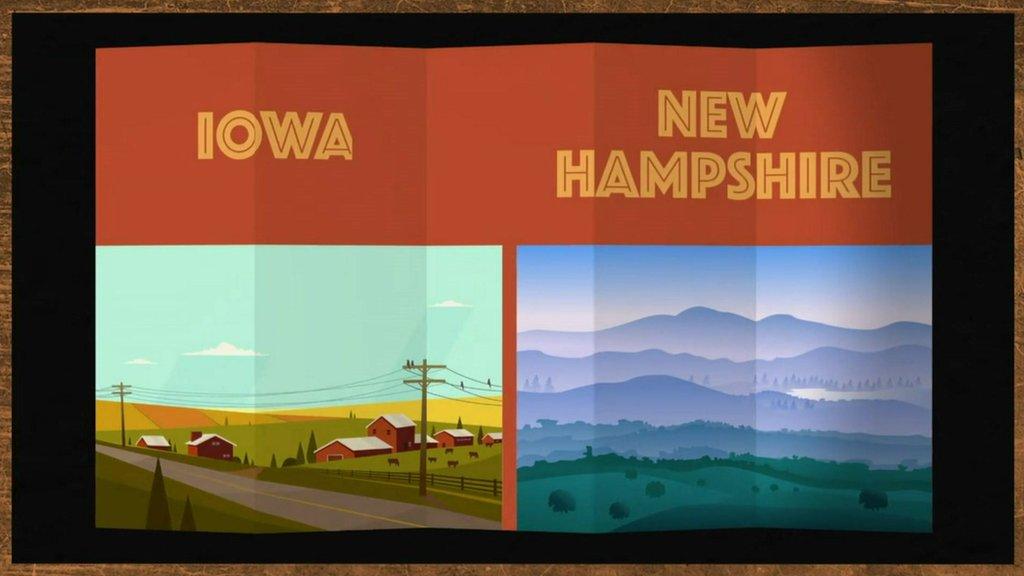US election 2016: Primaries, caucuses and delegates
- Published
Katty Kay explains the long and complex process for picking a presidential nominee
US presidential hopefuls have been trading barbs for months, but now the people get to have a say on who leads their party. Here's a guide to the long and complex primary process and how to keep track of who's winning.
The primaries and caucuses are all about winning delegates - party members from a state who pledge to endorse a candidate at the party conventions in July. The more state contests a candidate wins, the more delegates will be pledged to support them at the convention.
The delegate tracker
Follow the primaries race with the delegate tracker, provided by the Associated Press (AP)
The totals include the delegates won per state, as well as so-called "unpledged" or "super delegates". They are generally party leaders or elected officials, though the Democrats include former officials as well. Each super delegate is entitled to one vote at the convention.
AP conducts surveys of these super delegates, and adds them to a candidate's totals if they indicate their support. In the Democratic race, Hillary Clinton has gained the support of more than 300 super delegates so far.
Super delegates can - and do - change their minds during the course of the campaign, so the figures may shift as the race unfolds.
The delegate tracker is updated automatically. There may be a short delay between the delegates being assigned and the totals changing.
How do you win?
The more state contests a candidate wins, the more delegates will be pledged to support them at the convention.

As President Barack Obama cannot run again, both parties are holding competitive primaries this year.
The Republican candidate will need 1,237 delegates to win a majority, while the Democratic contender must secure 2,383.
What's the difference between a primary and a caucus?
There are several types of primary with different rules and methods used to win delegates.
"Open" primaries are open to all registered voters in that state, and they can vote for any candidate. A Republican voter can vote in the state's Democratic primary, and vice versa for example.
In a "closed" primary, only registered voters affiliated with each party in that state can vote.
In addition, there are also "semi-closed" primaries where voting is closed to registered members of the other party, but open to independents. There are about a half-dozen states that do this, including key early voting New Hampshire.
Caucuses are a series of meetings in which voters show their support for candidates with an open show of hands. Usually only registered voters, affiliated with that specific party, can take part.
When do they take place?

Presidential candidates cannot afford to ignore the two states which get to go first and second
The primary calendar lasts right up until June, but the early contests are most interesting as indicators of who will take the eventual crown.
The race usually reaches a climax on 1 March or 'Super Tuesday', with no less than 13 states holding primaries or caucuses for one or both parties on the same day.
Both parties hold primaries / caucuses on the same day (unless indicated)
February
Candidates seek to build momentum and stay in the race.
1 Feb: Iowa Caucuses
9 Feb: New Hampshire Primary
20 Feb: Nevada Caucuses (Democratic), South Carolina Primary (Republican)
23 Feb: Nevada Caucuses (Republican)
27 Feb: South Carolina Primary (Democratic)
March
Thirteen states vote on 'Super Tuesday', including six across the South. An opportunity to run the tables, and look like the 'invincible candidate', but the delegate maths can't be decided at this point.
1 March - 'Super Tuesday': Alabama, Arkansas, Georgia, Massachusetts, Oklahoma, Tennessee, Texas, Vermont, Virginia Primaries; Minnesota Caucuses, Alaska & Wyoming Caucuses (Republican), Colorado Caucuses (Democratic)
5 March: Kansas Caucuses, Louisiana Primary, Kentucky & Maine Caucuses (Republican), Nebraska Caucuses (Democratic)
6 March: Maine Caucuses (Democratic)
8 March: Hawaii & Idaho Caucuses (Republican), Idaho Primary (Republican), Michigan & Mississippi Primaries
15 March: Florida, Illinois, Missouri, North Carolina, Ohio Primaries
Big states with lots of delegates up for grabs, especially where it's winner takes all. Also swing states where electorates are more moderate so there's potential for an establishment candidate to make a comeback.
22 March: Arizona Primary, Utah Caucuses, Idaho Caucuses (Democratic)
26 March: Alaska, Hawaii, Washington Caucuses (Democratic)
April-May
These races may be more important than usual for the Republican race due to number of well-funded candidates this year, who may have the staying power to remain contenders until April.
1 April: North Dakota Caucuses (Republican)
5 April: Wisconsin Primary
9 April: Wyoming Caucuses (Democratic)
19 April: New York Primary
26 April: Connecticut, Delaware, Maryland, Pennsylvania, Rhode Island Primaries
3 May: Indiana Primary
10 May: West Virginia Primary, Nebraska Primary (Republican)
17 May: Oregon Primary, Kentucky Primary (Democratic)
24 May: Washington Primary (Republican)
June
7 June: California, Montana, New Jersey, New Mexico, South Dakota Primaries; North Dakota Caucuses (Democratic)
14 June: District of Columbia Primary (Democratic)
18-21 July: Republican National Convention
25-28 July: Democratic National Convention